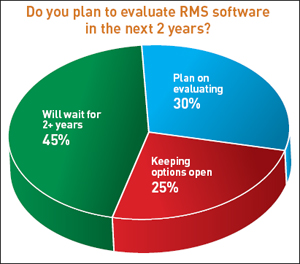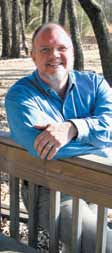My Favorite Things
Some of the best ideas from your minds
I have been privileged to tour a lot of rental and staging companies over the past five years. I can honestly say that every visit yields at least one thing that truly impresses me. Sometimes it’s a clever way to package gear, a thoughtful operational checklist, or warehouse layout that really works. Even the smallest detail has the potential to impress and probably makes someone’s life easier or the overall product better. In honor of Oprah’s retirement from daytime TV, I want to share a few of my favorite things in live event staging. In no particular order:
Specialized Warehouse Teams: In one busy rental shop, there is a team of veteran warehouse techs that provide concierge service to complicated or unusual shows while other welltrained workers focus on high volume rental orders. The show team reviews drawings, consults with account managers and show technicians, and coordinates with logistics to meet every detail of the specification. Results? Salespersons and field techs feel well cared for and mistakes were exceptionally low.
Shop Video Displays: Over the years I have seen many iterations of the warehouse video display of current orders. I have to admit that I love the use of show technology to improve office/ warehouse operations. I think my favorite application was a display to indicate which orders were currently being pulled, but any changes to these orders were shown at the top of the list. Warehouse techs could glance at the screen to see if the order they were currently working had any pending updates.
Onboarding and Offboarding Protocols: Many of us are familiar with human resources checklists for new or exiting employees. I was thrilled to see a new inventory checklist in one really organized shop. Whenever a product is ordered for rental inventory, the warehouse department receives a checklist of the item, dimensions, accessories, and case plan. Expected arrival dates are handy for knowing when to make room on the shelves. Added notes explain if the product is general stock, added to an existing system, or purchased for a specific project. Warehouse folks can send requests for shelving, accessories, or even training to work with the new items. The process reduces surprises, gets the team excited about upcoming purchases, and helps make sure that all details are accounted for. Not surprisingly, this company has a similar process for decommissioning equipment.
Timesheet “Points”: There are a number of payroll services that will allow employees to log their time online, via their computer, phone, or PDA. This is a great idea for field personnel that may not make it back to the office very often. However, many companies still have trouble getting their veteran show techs to record their hours — especially when they are salaried and don’t earn overtime. Enter timesheet points. One company’s online timesheet system logs the actual time that each day’s entry is made. The closer that each entry is made to the actual finish time, the more points the employee could earn. Employees can cash in their points for things they actually want. This company converts timesheet points to Amex points (earned from centralized travel booking) and gifts them to the participating employees. More points can be earned by turning in expense reports on time.
The Proposal Treatment: More stagers are adding graphics and creative departments to their services. Account managers are cranking out better-looking proposals that use the client’s logo and high-resolution images to show off the stager’s talents. When these two trends meet up — bam! Awesome-looking proposals. The graphics department manager at one company was unimpressed with the individual salespersons’ attempts at looking “creative” and asked to take over the proposal beautification process. She developed three proposal templates (to start) and catalogued a library of useful images. The Account manager simply submits a proposal budget (approved by the sales manager) to Graphics, who then gives it the royal treatment. The AM can specify required support materials and whether the proposal is repeat business, tender bid, or capabilities pitch. Graphics drops it in the appropriated template, adds images that reflect the people and technology being proposed, and sends back to the AM. The entire process takes less than 15 minutes for the largest proposals.
The Triple Check: Most Stagers utilize a pick list check-off system with one check or initial box per rental item. My readers will know that I advocate two checks: one from the person that picked the gear and another from someone that sees the items placed on the truck. While many folks hope that one day RFID or similar technology will replace human verification, one enterprising company settles for no less than three human checks. A warehouse tech picks the gear according to the pull sheet. A veteran supervisor then reviews the entire list, verifies each item is correct, and accounts for all sub-rentals and transfers. Then the logistics manager monitors the loading of the truck and accounts for each case and item shipped. The extra supervisor step in the middle takes an average of 10 to 15 minutes, but catches problems that might be found during the fourperson truck packing process, and would otherwise slow down the load and cost valuable man-hours.
This favorite things list is far from complete, and I could go on for pages. I hope at least one of these ideas spurs your own creative solution.
Tom Stimson, MBA, CTS, is president of The Stimson Group, a Dallas-based management consulting firm providing strategic planning, market research, and profit-through-process services to the audiovisual industry. Tom is the chairman of Leadership Development Committee and Adjunct Instructor for InfoComm International, a member of numerous corporate advisory boards, and keynote speaker for the Rental & Staging Roadshow. Contact him at tom@trstimson.com.
Market Snapshot Signs of Resurgence

In July of 2011, The Stimson Group conducted a survey of rental companies about rental management software. Almost 200 folks participated from 150 companies. Filtering out the duplicate company results, companies reported that they have used their current software package for an average of 6.4 years. And 34 percent reported that they have used their system for ten years or more!
Everyone has a few complaints about how their software functions, but 47 percent of respondents said they were likely to recommend their current system to others. While this is a healthy positive response, not everyone was willing to settle for their current capabilities: 30 percent plan on actively looking at new offerings in the next 24 months and another 25 percent are keeping their eyes open to for a better system. The remaining 45 percent plan on keeping their current system at least two more years.
The potential for half the rentalstaging marketing to replace or update their systems in the next two years is quite the bellwether. Major software migrations are the last thing troubled companies would ever consider. Even if only 10 percent made a move, that would represent a significant boost in software expenditures and a sign that capital spending has returned. However, software manufacturers will be quick to point out that most companies take many months and often years to evaluate, choose, and implement new rental management technology.
